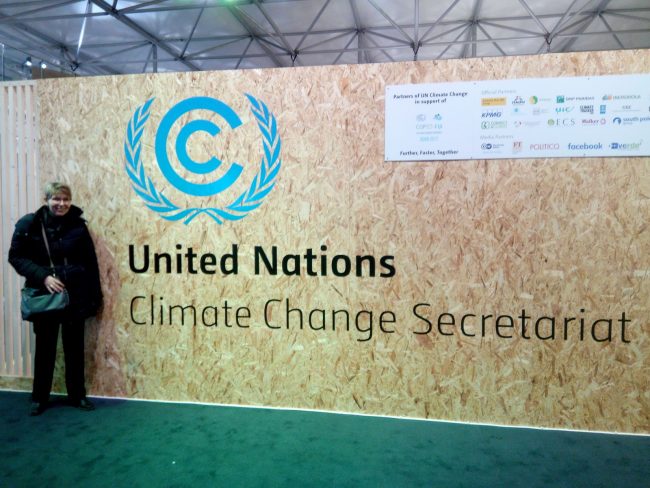When reporting on my recent trip to Bonn, Germany for the COP23, I learned about the work of an artist in the region of Southern France who adds a poignant reality to the work being done by the nations of the world to reduce CO2 emissions and deal with adaptability to this new world we live in. I provide a photo and a letter from the artist to you about her work. Many of you, living in British Columbia, will understand the beauty and importance of the whale in our complex ecosystem. This painting touched me, and I hope it speaks to you.
A Message From The Artist
My name is Patricia Lyons. I am the artist.
This is the rib cage of the skeleton of a whale. I painted it from a photo I took of the skeleton which resides in Kew Gardens, London in the children’s educational area.
The whale’s feeding grounds are at risk; firstly, due to the loss of krill, secondly because of the high salt content on the ice and thirdly due to global warming, their cold waters are warming on the way to the tropics and the whale interprets in this rise in temperature that they have reached the tropics for breeding.
A whale (example the Humpback) which feeds on krill in the arctic will consume 4,000 kilos of krill a day for 120 days before travelling to the tropics some 12,000 kms away to breed. The krill has now depleted by 80% due to global warming due to the greenhouse effect which has caused the thinning of the ice caps and a higher salt content lying on top of the ice which is in fact warming the seas (salt increases temperatures) (killing the krill) under which the krill lives.
For the whale both the lack of krill (feeding is March to November) and the thinning of the ice puts it at risk given that there is a serious loss of blubber necessary for insulation in their arctic habitat and not enough food to sustain long months of breeding without feeding (from November to February). The loss of krill also means that the females when they are in a state of hunger will refuse to copulate thus affecting the loss of a new generation of whales.
As one scientist said; “this is the canary in the coal mine” which should be a warning as to how the rest of our world is at risk. We all must take immediate action to ensure these appalling symptoms of global warming do not accelerate before they begin ‘to bite’. ~ Patricia Lyons
Photo Credits
Art by Patricia Lyons
Photos by Charalee Graydon
Guest Author Bio
Charalee Graydon

Charalee Graydon was born in Alberta, Canada. She is a writer, journalist, academic and past lawyer. She works in the areas mediation and collaboration and is currently a faculty member at EUCLID University.
Charalee holds degrees in Bachelor of Arts in English and Political Science, and a Juris Doctorate in Law. Following receipt of a Rhodes scholarship in 1982, she pursued legal studies in Oxford, England where she obtained a B.C. L degree. She held academic positions in England, New Zealand, and Canada and is presently a faculty member at Euclid University. She practiced law in Canada.
She has published three books of literary fiction and one of which has been translated and published in Spanish.
She developed programs for students, judges, and the corporations on legal issues and published academic works in environmental law, sentencing and commercial law.
Blog / Website: Charaleeg.com
Recent Guest Author Articles:
- How Does Ultrasound Therapy Enhance Skin Firmness Without Surgery?
- From License to Lifestyle - How State Choice Impacts Nursing Journeys
- Your Online Reputation Is Everything (Here's How to Build It Fast)
- 5 Spiritual Resources to Help Humanity in Times of Crisis
- Between Judgment and Hope: Navigating the Gray Areas of the Justice System




Please Share Your Thoughts - Leave A Comment!